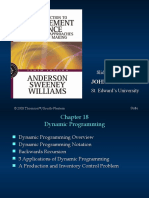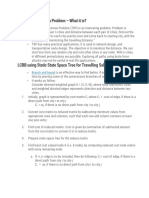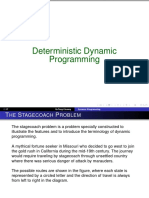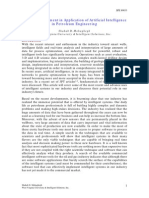0 ratings0% found this document useful (0 votes)
2 viewsWeek 10 -Dynamic Programming
Uploaded by
eshaasif005Copyright
© © All Rights Reserved
Available Formats
Download as PPTX, PDF, TXT or read online on Scribd
0 ratings0% found this document useful (0 votes)
2 viewsWeek 10 -Dynamic Programming
Uploaded by
eshaasif005Copyright
© © All Rights Reserved
Available Formats
Download as PPTX, PDF, TXT or read online on Scribd
You are on page 1/ 12
INTRODUCTION TO
OPERATIONS RESEARCH
Deterministic Dynamic Programming
DYNAMIC PROGRAMMING
Dynamic programming is a widely-used
mathematical technique for solving
problems that can be divided into
stages and where decisions are required
in each stage.
The goal of dynamic programming
is to find a combination of decisions
that optimizes a certain amount
associated with a system.
DETERMINISTIC DYNAMIC
PROGRAMMING
By the time the last sub problem is solved, the optimum
solution for the entire problem is at hand. The manner in
which the recursive computations are carried out
depends on how we decompose the original problem
In particular, the sub problems are normally linked by
common constraints. As we move from one sub problem
to the next, the feasibility of these common constraints
must be maintained
DYNAMIC PROGRAMMING
Dynamic programming does not exist a standard
mathematical formulation of “the” dynamic programming
problem. Rather, dynamic programming is a general type
of approach to problem solving, and the particular
equations used must be developed to fit each situation.
DYNAMIC PROGRAMMING
Dynamic programming starts with small portion of the
original problem and finds the optimal solution for this
smaller problem. It then gradually enlarges the problem,
finding the current optimal solution from the preceding
one, until the original problem is solved in its entirety.
GENERAL CHARACTERISTICS OF
DYNAMIC PROGRAMMING
The problem structure is divided into stages
Each stage has a number of states associated with it
Making decisions at one stage transforms one state of the
current stage into a state in the next stage.
Given the current state, the optimal decision for each of the
remaining states does not depend on the previous states or
decisions. This is known as the principle of optimality for
dynamic programming.
The principle of optimality allows to solve the problem stage
by stage recursively.
DIVISION INTO STAGES
The problem is divided into smaller subproblems
each of them represented by a stage.
The stages are defined in many different ways
depending on the context of the problem.
If the problem is about long-time development of
a system then the stages naturally correspond to
time periods.
If the goal of the problem is to move some objects
from one location to another on a map then
partitioning the map into several geographical
regions might be the natural division into stages.
Generally, if an accomplishment of a certain task
can be considered as a multi-step process then
each stage can be defined as a step in the
STATES
Each stage has a number of states associated with
it. Depending what decisions are made in one
stage, the system might end up in different
states in the next stage.
If a geographical region corresponds to a stage
then the states associated with it could be some
particular locations (cities, warehouses, etc.) in
that region.
In other situations a state might correspond to
amounts of certain resources which are essential
for optimizing the system.
DECISIONS
Making decisions at one stage transforms one state
of the current stage into a state in the next stage.
In a geographical example, it could be a decision to
go from one city to another.
In resource allocation problems, it might be a
decision to create or spend a certain amount of a
resource.
For example, in the shortest path problem three
different decisions are possible to make at the
state corresponding to Columbus; these decisions
correspond to the three arrows going from
Columbus to the three states (cities) of the next
stage: Kansas City, Omaha, and Dallas.
You might also like
- 5808A1625 Bs Cat Optiplanning Mag19 ENG LR100% (1)5808A1625 Bs Cat Optiplanning Mag19 ENG LR12 pages
- Variables. These Variables Provide Information For Analyzing The Possible Effects That The Current DecisionNo ratings yetVariables. These Variables Provide Information For Analyzing The Possible Effects That The Current Decision5 pages
- Operation Research 2 Dynamic ProgrammingNo ratings yetOperation Research 2 Dynamic Programming34 pages
- ESI 4313 Operations Research 2: Dynamic ProgrammingNo ratings yetESI 4313 Operations Research 2: Dynamic Programming52 pages
- Process Optimisation: Dynamic ProgrammingNo ratings yetProcess Optimisation: Dynamic Programming35 pages
- PPT3 - W2-S3 - Dynamic Programming - R0No ratings yetPPT3 - W2-S3 - Dynamic Programming - R029 pages
- The Analysis of Forward and Backward Dynamic Programming For Multistage GraphNo ratings yetThe Analysis of Forward and Backward Dynamic Programming For Multistage Graph7 pages
- Dynamic Programming Presentation (Autosaved)No ratings yetDynamic Programming Presentation (Autosaved)17 pages
- 25-Introduction To Dynamic Programming-08-03-2024No ratings yet25-Introduction To Dynamic Programming-08-03-202443 pages
- 06DynamicProgrammingAndGreedy EditedolgaNo ratings yet06DynamicProgrammingAndGreedy Editedolga46 pages
- File 1716180627 66059 DynamicProgrammingNo ratings yetFile 1716180627 66059 DynamicProgramming9 pages
- Water Resources Systems:: Modeling Techniques and AnalysisNo ratings yetWater Resources Systems:: Modeling Techniques and Analysis15 pages
- Powell - Modernizing The Teaching of Optimization January 5 2024No ratings yetPowell - Modernizing The Teaching of Optimization January 5 20248 pages
- Automated Planning and Scheduling: Fundamentals and ApplicationsFrom EverandAutomated Planning and Scheduling: Fundamentals and ApplicationsNo ratings yet
- Linear Programming: X in This Case) - The Inequalities Ax B and X 0 Are TheNo ratings yetLinear Programming: X in This Case) - The Inequalities Ax B and X 0 Are The5 pages
- AIMMS Modeling Guide - Linear Programming TricksNo ratings yetAIMMS Modeling Guide - Linear Programming Tricks16 pages
- Control System Design: School of Engineering and Information TechnologyNo ratings yetControl System Design: School of Engineering and Information Technology45 pages
- Simulation Design Optimal Operation of LNG Processes For Arctic ConditionsNo ratings yetSimulation Design Optimal Operation of LNG Processes For Arctic Conditions44 pages
- AI-driven Prediction Based Energy-Aware Fault-Tolerant Scheduling Scheme (PEFS) For Cloud Data Center AbstractNo ratings yetAI-driven Prediction Based Energy-Aware Fault-Tolerant Scheduling Scheme (PEFS) For Cloud Data Center Abstract16 pages
- Recent Development in Application of Artificial Intelligence in Petroleum EngineeringNo ratings yetRecent Development in Application of Artificial Intelligence in Petroleum Engineering21 pages
- (2023) Reliability Based Structural Optimization Using Adaptive Neural Network Multisphere Importance SamplingNo ratings yet(2023) Reliability Based Structural Optimization Using Adaptive Neural Network Multisphere Importance Sampling25 pages
- Introduction To Dynamic Systems: Theory, Models, and Applications - David G. LuenbergerNo ratings yetIntroduction To Dynamic Systems: Theory, Models, and Applications - David G. Luenberger3 pages
- Combinatorial Optimization - Chekuri (2022)No ratings yetCombinatorial Optimization - Chekuri (2022)255 pages
- MCA18R5103-Soft Computing Techniques Question Bank: 2 MarksNo ratings yetMCA18R5103-Soft Computing Techniques Question Bank: 2 Marks3 pages
- Sae Technical Paper Series: Taehyun Shim and Pradheep C VelusamyNo ratings yetSae Technical Paper Series: Taehyun Shim and Pradheep C Velusamy15 pages
- Application of Gis in Landuse Planning A Case Stu-Wageningen University and Research 33537No ratings yetApplication of Gis in Landuse Planning A Case Stu-Wageningen University and Research 335378 pages
- Variables. These Variables Provide Information For Analyzing The Possible Effects That The Current DecisionVariables. These Variables Provide Information For Analyzing The Possible Effects That The Current Decision
- ESI 4313 Operations Research 2: Dynamic ProgrammingESI 4313 Operations Research 2: Dynamic Programming
- The Analysis of Forward and Backward Dynamic Programming For Multistage GraphThe Analysis of Forward and Backward Dynamic Programming For Multistage Graph
- Water Resources Systems:: Modeling Techniques and AnalysisWater Resources Systems:: Modeling Techniques and Analysis
- Powell - Modernizing The Teaching of Optimization January 5 2024Powell - Modernizing The Teaching of Optimization January 5 2024
- Markov Decision Process: Fundamentals and ApplicationsFrom EverandMarkov Decision Process: Fundamentals and Applications
- Automated Planning and Scheduling: Fundamentals and ApplicationsFrom EverandAutomated Planning and Scheduling: Fundamentals and Applications
- Linear Programming: X in This Case) - The Inequalities Ax B and X 0 Are TheLinear Programming: X in This Case) - The Inequalities Ax B and X 0 Are The
- Control System Design: School of Engineering and Information TechnologyControl System Design: School of Engineering and Information Technology
- Simulation Design Optimal Operation of LNG Processes For Arctic ConditionsSimulation Design Optimal Operation of LNG Processes For Arctic Conditions
- AI-driven Prediction Based Energy-Aware Fault-Tolerant Scheduling Scheme (PEFS) For Cloud Data Center AbstractAI-driven Prediction Based Energy-Aware Fault-Tolerant Scheduling Scheme (PEFS) For Cloud Data Center Abstract
- Recent Development in Application of Artificial Intelligence in Petroleum EngineeringRecent Development in Application of Artificial Intelligence in Petroleum Engineering
- (2023) Reliability Based Structural Optimization Using Adaptive Neural Network Multisphere Importance Sampling(2023) Reliability Based Structural Optimization Using Adaptive Neural Network Multisphere Importance Sampling
- Introduction To Dynamic Systems: Theory, Models, and Applications - David G. LuenbergerIntroduction To Dynamic Systems: Theory, Models, and Applications - David G. Luenberger
- MCA18R5103-Soft Computing Techniques Question Bank: 2 MarksMCA18R5103-Soft Computing Techniques Question Bank: 2 Marks
- Sae Technical Paper Series: Taehyun Shim and Pradheep C VelusamySae Technical Paper Series: Taehyun Shim and Pradheep C Velusamy
- Application of Gis in Landuse Planning A Case Stu-Wageningen University and Research 33537Application of Gis in Landuse Planning A Case Stu-Wageningen University and Research 33537

























































































